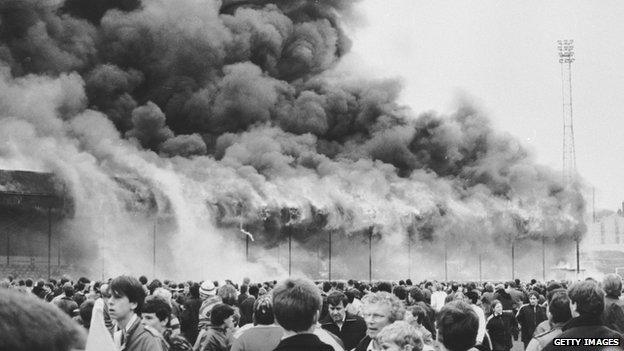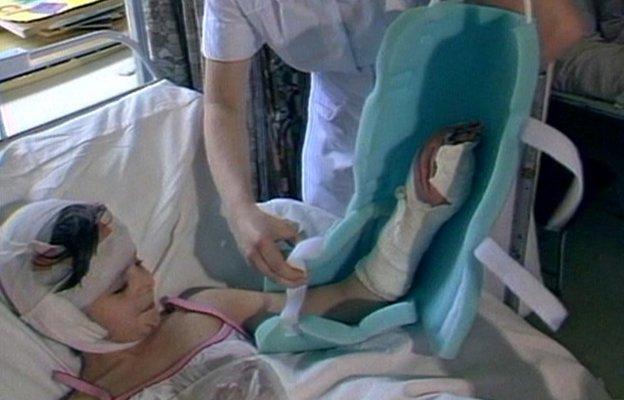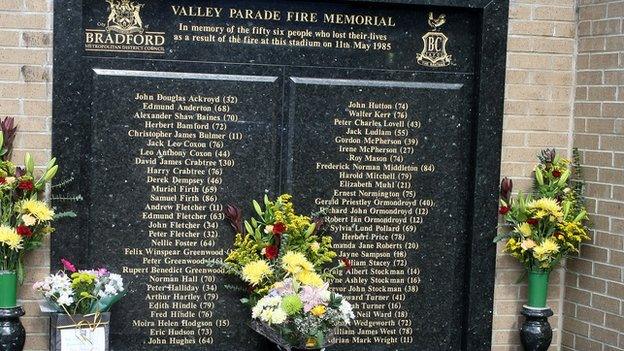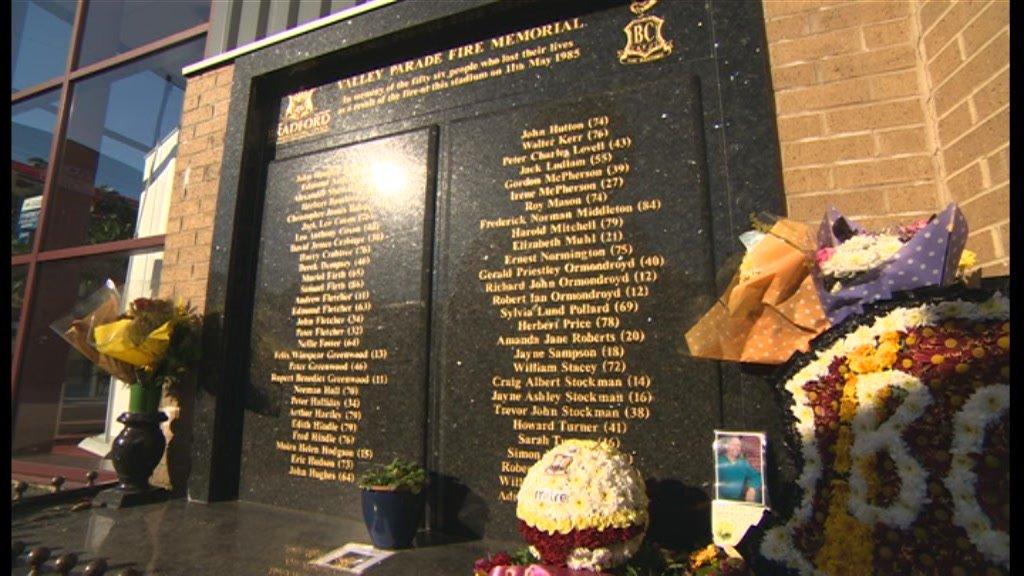Bradford City football stadium blaze surgeon honoured
- Published

The fire in 1985 destroyed the all-wood main stand at Bradford's ground in minutes, leaving 56 fans dead and hundreds more injured
It is nearly three decades since a fire swept through Bradford City's Valley Parade ground, killing 56 people and injuring hundreds more.
And yet a pioneering burns research unit set up in its aftermath and funded largely by donations continues to thrive, with its founder still considered some sort of local hero.
Prof David Sharpe, who was presented with an award during Bradford City's last home game of the season, still finds that status surprising.
"I think there's a bit of a myth that I personally dragged people out of the stand and saved their lives but that's not true," he said.
"I just did what I was paid to do."
Prof Sharpe had been working as a consultant plastic surgeon for just five months and was on call when fire broke out during a match between Bradford and Lincoln, on 11 May 1985.
He treated and planned surgery for more than 200 people who had suffered burns, mainly to the hands, scalp and back of legs.
"You become very fond of people when you're treating them like that, there is a lot of camaraderie on the ward, it's like a family," he said.

More than 200 people were injured and about 25 of those needed lengthy surgery
One of the many people injured that day was Matthew Wildman, who told the BBC "[I] looked down at my hands and they were bubbling like melting cheese".
The then 17-year-old was sitting in the block adjacent to where the fire started.
It is thought a lit cigarette or match dropped onto rubbish beneath the club's wooden main stand could have sparked the blaze, which took no more than four minutes to leave 56 spectators fatally injured.
Mr Wildman was "badly burned from head to foot" and was taken to St Luke's hospital in Bradford where he was treated by Prof Sharpe and his team.
"I must have had five different experiments carried out on me with all sorts of new techniques for skin grafts and I had potions injected into me that helped my face repair naturally over time," he said.
"The entire team was superb."
In the weeks after the fire, Prof Sharpe helped found the Plastic Surgery and Burns Research Unit at the University of Bradford, where he was director until retiring in December last year.
The centre does not treat burn victims but carries out stem cell research to try to find new ways to treat the injuries and speed up the healing process.

Prof David Sharpe designed the Bradford Sling which was used to help burns victims after the disaster
It was established by, and continues to exist through, donations from members of the public.
At the beginning it was also assisted by the royalties from Prof Sharpe's "Bradford sling", which he designed and used to help those injured in the disaster.
An appeal by Bradford's Telegraph and Argus newspaper to mark the 25th anniversary of the disaster raised more than £167,000 - enough to fund the unit for several more years.
Prof Sharpe said: "It's gone on much longer than expected."
And Alan Carling, of the Bradford City Supporters' Board, thinks that support will continue for a long time, despite Prof Sharpe's departure.

Prof Sharpe was presented with a plaque at half-time during Bradford's match against Crawley Town
"It's the lasting tribute - the institutional tribute - to the 56 who died," he said.
"A lot of people owe their quality of life to Professor Sharpe and his colleagues in the early days of the burns research unit.
"He was thrown in to the middle of an awful situation but his response to it led to great improvements in treatment to burns victims, and that has continued to this day."
Prof Sharpe has described the tragedy as a "catalyst" that led to research and improvements.
"Initially, the value of the unit was in clinical studies, for example research into scalp burns, which lots of people suffered at Bradford City, and treating them by putting a balloon under the scalp to stretch out the skin.
"Burns will always be with us, so if we can speed up the healing process and make it easier it has long-term benefits."
The presentation ceremony to mark Prof Sharpe's retirement was held at half-time on the pitch during Bradford's League One match, external against Crawley Town.
- Published20 April 2014

- Published21 February 2013
